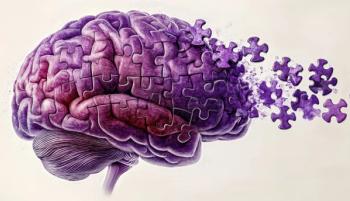SPECIAL REPORT: GERIATRIC PSYCHIATRY
By the time COVID-19 was characterized as a pandemic, it was clear that older adults in general, and those with Alzheimer disease and related dementias (ADRD) in particular, would be severely impacted both directly by the virus and indirectly by the social consequences and responses.1 Now, approaching 2 years since SARS-CoV-2 emerged, we are starting to measure the impact of COVID-19 on older patients with cognitive impairment and ADRD. Further, we can begin to review neurobiological issues associated with COVID-19 in older adults, and consider how COVID-19 may contribute to cognitive impairment and future cases of dementia.
The Impact of COVID-19 on Older Adults
Also In This Special Report
Rajesh R. Tampi, MD, MS, DFAPA, DFAAGP
Joan M. Cook, PhD; Bret R. Rutherford, MD; and Ron Acierno, PhD
Christine Juang, PhD; Colleen Mills-Finnerty, PhD; Erin Cassidy-Eagle, PhD, DBSM; Makoto Kawai, MD; Christine Gould, PhD
The demographics of COVID-19 cases have shifted over time, with older adults being most impacted early in the pandemic, and later waves involving younger individuals.2 Similarly, risk varied by setting, with an early wave of COVID-19 cases in congregate settings including nursing homes, retirement homes, and hospitals. These frequent and widespread outbreaks were associated with significant morbidity and mortality. Despite campaigns to vaccinate nursing home residents, they still account for a large proportion of the total deaths due to COVID-19.3,4
The severity of COVID-19 spans the spectrum from asymptomatic carrier state to severe illness and death, with age being the strongest demographic risk factor for a more severe illness: Age has an exponential relationship with infection fatality rate, reaching 15% at age 85.5 Older adults with cognitive impairment are doubly at risk, with age and cognitive impairment independently contributing to illness severity.6 Cognitive impairment has been associated with double the risk of COVID-19 mortality in nursing homes.3 Even when controlling for residence in a nursing home, those with dementia had twice the risk of acquiring COVID-19.7
We had anticipated that rates of behavioral and psychologic symptoms associated with dementia (BPSD) would increase as a result of indirect factors such as disruption to care, social isolation, and disruption to routine.1,8 Unfortunately, this has been borne out, with studies reporting increases in BPSD including anxiety, depression, insomnia, wandering, and agitation.9
Alongside the risk of mortality, the pandemic is also affecting mental health negatively, both via the direct effect of the virus and indirectly via the massive disruption to society in response to the pandemic. Early and ongoing mental health consequences of the pandemic include increased rates of symptoms of depression, anxiety, substance use, and suicidal ideation. However, paradoxically, younger individuals may be more impacted than older ones.10 Similarly, while the pandemic may have increased BPSD in some individuals with dementia, this has not been universally true. For example, in New Brunswick, Canada, despite a marked reduction in family visits and periods of lockdown (mitigated by virtual visits and volunteer services), there was no change in rates of agitation, and a reduction in rates of depression among nursing home residents, with more than half of them having dementia.11
The availability of safe and effective COVID-19 vaccines is thought to be a key element to ending the pandemic. Early on, in the context of limited supply, governments prioritized vaccination for high-risk groups such as the elderly and those living in long-term care (LTC) facilities. Thus, most individuals with dementia were prioritized for vaccination. For example, in Ontario, Canada, despite only 0.5% of the population living in LTC facilities, vaccination initially was reserved for LTC residents and health professionals when vaccines first became available in December 2019.12 By March 2020, more than 92% of LTC residents had received at least 1 dose of a COVID-19 vaccine, which was estimated to have reduced mortality by 96%.12 The recent approval by the US Food and Drug Administration of booster shots for older persons (ie, a third dose) may offer them further protection and also deepen current inequities when vaccination remains unavailable due to supply constraints in some jurisdictions.
The Neurobiology of COVID-19
COVID-19 is transmitted person to person via inhalation of respiratory droplets and their deposition on mucous membranes, and to a lesser extent by contaminated hands contacting mucous membranes.13 The virus enters cells via the angiotensin-converting enzyme 2 receptor, present not only in the respiratory and gastrointestinal tract but also in other organs, including the brain and blood vessels.14,15 Thus, COVID-19 can potentially lead to neuropathology via systemic and inflammatory indirect effects and by its direct action on the nervous system.
Although most cases of COVID-19 are classified as mild, severe cases occur in individuals of all ages, most commonly in older adults. Common acute symptoms include cough, fever, fatigue, headache, myalgias, and diarrhea.16 Symptoms can progress and involve hypoxemia and acute respiratory distress syndrome.16 In addition, injury to all organ systems due to severe inflammation, thromboembolic events, and neurologic complications can occur.16
The neurologic consequences of severe COVID-19 are common and involve both the central nervous system (CNS) and peripheral nervous system (PNS) (Table).17 Dizziness and headache are the most common CNS manifestations, which can also include cerebrovascular disease (eg, ischemic stroke, hemorrhage), ataxia, and seizure. Delirium is a common presentation of older adults with COVID-19; it has a very poor prognosis and is associated with permanent cognitive impairment.18 Anosmia and ageusia are the most common PNS manifestations.17
Neurologic manifestations can occur within the first days of illness and persist months after hospital discharge.17,19 Isolating the virus in cerebrospinal fluid is rare.20 Cognitive impairment is a commonly reported symptom in survivors of severe COVID-19 at 60 days post discharge.19 Although research is needed to confirm the neuropsychiatric sequelae of COVID-19, a broad spectrum of neuropsychiatric symptoms have been reported, including headaches, sleep disorders, encephalopathy, myalgia, and ageusia.21 The term long COVID refers to the persistence of symptoms after the resolution of the acute infection, and a broad range of symptoms have been reported, including neuropsychiatric symptoms such as cognitive impairment, insomnia, impaired concentration, posttraumatic symptoms, and headache.15 Long COVID is not always associated with the severity of acute COVID-19 or risk factors for severe COVID-19, and it may involve multiple organ damage by other direct mechanisms.22 Long COVID is thought to be relatively common, but estimates of its prevalence vary widely depending on definition and time since infection. It may also depend on the SARS-CoV-2 genetic variant.15
There is evidence for both structural and functional brain changes following COVID-19, and these changes may be associated with the neurologic symptoms of long COVID. Various studies have reported heterogenous findings. A recent systematic review summarizing the neuroimaging findings associated with COVID-19 in older adults reported widespread neuropathological issues typically associated with cerebrovascular damage, most consistently in white matter, brainstem, and frontotemporal cortical areas.23 A case-control study of patients who recovered from COVID-19 found hypometabolism in frontotemporal regions, which was associated with neurological symptoms.24 A study of United Kingdom Biobank participants by Douaud et al found changes in 394 individuals who had brain imaging before and after a COVID-19 infection, compared with 388 matched controls without a history of COVID-19. Among those who had survived COVID-19, Douaud et al identified reductions in grey matter in the left parahippocampal gyrus, left lateral orbitofrontal cortex, and left insula.25
The Long-Term Consequences of COVID-19
Although it is staggering that approximately 1 in 500 Americans has died of COVID-19, mortality is the tip of the iceberg. The Centers for Disease Control and Prevention estimates that as of May 29, 2021, there had been more than 100 million individuals with symptomatic COVID-19 in the United States, 10 million of them 65 years or older.26 The sequelae from severe COVID-19 are risk factors for dementia, and they may increase the growing number of individuals living with dementia. Understanding the specific contribution of a past COVID-19 infection on future risks of dementia will require longitudinal studies. These risks may be substantial given the cerebrovascular changes associated with past infection. During the next few years, post-COVID-19 issues may occur mostly in older adults. However, COVID-19 may also increase the risk of future cognitive impairment and dementia in younger individuals, because early life experiences and exposures contribute to the risk of dementia, as is the case in other risk factors for dementia such as low level of education or depression early in life. The magnitude of the current and future human, financial, and societal cost of COVID-19 is unknown, but certainly worrisome.
On the other hand, we expect that the pandemic will lead to numerous changes that benefit older adults. Specifically, the spotlight on nursing homes has revealed systemic flaws and inequities in many countries that now will be hard to ignore. The pivot to virtual care has spurred some innovation that may facilitate access to care going forward.
In our own experience, working at the Centre for Addiction in Mental Health in Toronto, we have had to pivot to providing care to older individuals despite multiple waves of COVID-19 cases in the community. Some of the changes in our practice and our environment will have long-lasting benefits. The heterogeneity of real-world experience, compared with averages often reported in research, is humbling. Some of our older patients have shown remarkable resilience through the pandemic and have adjusted their lifestyle to thrive during this time. Others have had their usual coping mechanisms totally disrupted and are suffering, needing additional mental health and social resources. In our geriatric mental health inpatient unit, technology (eg, internet-connected tablets) has been helpful to connect patients to family, activities, and entertainment. We have also noticed an improved access to specialist consultations with virtual care and additional physician-to-physician consultation options. In our outpatient setting, virtual care options introduced to reduce risk of COVID-19 have also reduced barriers for certain patients who prefer it or may have mobility issues.
Concluding Thoughts
The impact of the pandemic on older adults and those with dementia has been immense. Vaccination can dramatically reduce severe outcomes from COVID-19 in older adults. The indirect impact of the pandemic on individuals with dementia, such as isolation and disruption of care, can be pronounced, but they can also be mitigated. COVID-19 causes neurological damage that is not restricted to severe cases or older adults. A significant proportion of individuals infected by COVID-19 will experience long-term negative impact, including an increased risk of dementia. Research to better understand the neurobiology and the long-term neuropsychiatric impacts of COVID-19 is critical, as it will shift the understanding of the risk-benefit of population-level interventions to prevent COVID-19. The pandemic is not over. Efforts to protect everyone, including older adults, from COVID-19 are essential.
Dr Brown is an assistant professor of psychiatry at the University of Toronto and a clinician scientist at the Campbell Family Mental Health Research Institute, Centre for Addiction and Mental Health, in Toronto, Canada. Dr Rajji is an associate professor of psychiatry at the University of Toronto and chief of geriatric psychiatry at the Centre for Addiction and Mental Health. Dr Mulsant is the Labatt Family Chair of the Department of Psychiatry in the Faculty of Medicine at the University of Toronto and a clinician scientist in the Campbell Family Mental Health Research Institute, Centre for Addiction and Mental Health.
References
1. Brown EE, Kumar S, Rajji TK, et al. Anticipating and mitigating the impact of the COVID-19 pandemic on Alzheimer’s disease and related dementias. Am J Geriatr Psychiatry. 2020;28(7):712-721.
2. Boehmer TK, DeVies J, Caruso E, et al. Changing age distribution of the COVID-19 pandemic – United States, May-August 2020. MMWR Morb Mortal Wkly Rep. 2020;69(39):1404-1409.
3. Panagiotou OA, Kosar CM, White EM, et al. Risk factors associated with all-cause 30-day mortality in nursing home residents with COVID-19. JAMA Intern Med. 2021;181(4):439-448.
4. Grabowski DC, Mor V. Nursing home care in crisis in the wake of COVID-19. JAMA. 2020;324(1):23-24.
5. Levin AT, Hanage WP, Owusu-Boaitey N, et al. Assessing the age specificity of infection fatality rates for COVID-19: systematic review, meta-analysis, and public policy implications. Eur J Epidemiol. 2020;35(12):1123-1138.
6. Tahira AC, Verjovski-Almeida S, Ferreira ST. Dementia is an age-independent risk factor for severity and death in COVID-19 inpatients. Alzheimers Dement. Published online April 21, 2021.
7. Wang Q, Davis PB, Gurney ME, Xu R. COVID-19 and dementia: analyses of risk, disparity, and outcomes from electronic health records in the US. Alzheimers Dement. 2021;17(8):1297-1306.
8. Keng A, Brown EE, Rostas A, et al. Effectively caring for individuals with behavioral and psychological symptoms of dementia during the COVID-19 pandemic. Front Psychiatry. 2020;11:573367.
9. Dellazizzo L, Léveillé N, Landry C, Dumais A. Systematic review on the mental health and treatment impacts of COVID-19 on neurocognitive disorders. J Pers Med. 2021;11(8):746.
10. Czeisler MÉ, Lane RI, Wiley JF, et al. Follow-up survey of US adult reports of mental health, substance use, and suicidal ideation during the COVID-19 pandemic, September 2020. JAMA Netw Open. 2021;4(2):e2037665.
11. McArthur C, Saari M, Heckman GA, et al. Evaluating the effect of COVID-19 pandemic lockdown on long-term care residents’ mental health: a data-driven approach in New Brunswick. J Am Med Dir Assoc. 2021;22(1):187-192.
12. Brown KA, Stall NM, Vanniyasingam T, et al. Early impact of Ontario’s COVID-19 vaccine rollout on long-term care home residents and health care workers. Science Table: COVID-19 Advisory for Ontario. March 8, 2021. Accessed October 5, 2021. https://covid19-sciencetable.ca/wp-content/uploads/2021/03/Science-Brief_LTC-and-Vaccine_20210308_version-1.1_published-1.pdf
13. Scientific brief: SARS-CoV-2 transmission. Centers for Disease Control and Prevention. Updated May 7, 2021. Accessed September 28, 2021. https://www.cdc.gov/coronavirus/2019-ncov/science/science-briefs/sars-cov-2-transmission.html
14. Hamming I, Timens W, Bulthuis MLC, et al. Tissue distribution of ACE2 protein, the functional receptor for SARS coronavirus. a first step in understanding SARS pathogenesis. J Pathol. 2004;203(2):631-637.
15. Crook H, Raza S, Nowell J, et al. Long Covid – mechanisms, risk factors, and management. BMJ. 2021;374:n1648.
16. Berlin DA, Gulick RM, Martinez FJ. Severe Covid-19. N Engl J Med. 2020;383(25):2451-2460.
17. Mao L, Jin H, Wang M, et al. Neurologic manifestations of hospitalized patients with coronavirus disease 2019 in Wuhan, China. JAMA Neurol. 2020;77(6):683-690.
18. Marengoni A, Zucchelli A, Grande G, et al. The impact of delirium on outcomes for older adults hospitalised with COVID-19. Age Ageing. 2020;49(6):923-926.
19. Chopra V, Flanders SA, O’Malley M, et al. Sixty-day outcomes among patients hospitalized with COVID-19. Ann Intern Med. 2021;174(4):576-578.
20. García-Azorín D, Abildúa MJA, Aguirre MEE, et al; Spanish neuroCOVID registry group. Neurological presentations of COVID-19: findings from the Spanish Society of Neurology neuroCOVID-19 registry. J Neurol Sci. 2021;423:117283.
21. Nalleballe K, Reddy Onteddu S, Sharma R, et al. Spectrum of neuropsychiatric manifestations in COVID-19. Brain Behav Immun. 2020;88:71-74.
22. Yong SJ. Long COVID or post-COVID-19 syndrome: putative pathophysiology, risk factors, and treatments. Infect Dis (Lond). 2021;53(10):737-754.
23. Manca R, De Marco M, Ince PG, Venneri A. Heterogeneity in regional damage detected by neuroimaging and neuropathological studies in older adults with COVID-19: a cognitive-neuroscience systematic review to inform the long-term impact of the virus on neurocognitive trajectories. Front Aging Neurosci. 2021;13:646908.
24. Guedj E, Campion JY, Dudouet P, et al. 18F-FDG brain PET hypometabolism in patients with long COVID. Eur J Nucl Med Mol Imaging. 2021;48(9):2823-2833.
25. Douaud G, Lee S, Alfaro-Almagro F, et al. Brain imaging before and after COVID-19 in UK Biobank. medRxiv. Preprint posted online June 20, 2021.
26. Estimated COVID-19 burden. Centers for Disease Control and Precention. Updated July 27, 2021. Accessed September 28, 2021. https://www.cdc.gov/coronavirus/2019-ncov/cases-updates/burden.html ❒














